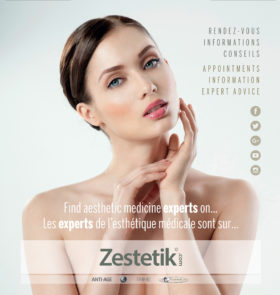Dr Claude Le Louarn
Invited by Clinique Nescens Paris Spontini, Dr Claude Le Louarn, Reconstructive and Aesthetic Plastic Surgery specialist, expressed his views on his profession. No scalpel nor syringe in his wealth of words and ideas, but rather an invitation to happiness.
We are living in a paradoxical era where nothing is natural anymore but everything must appear so, which intimates to focus on a natural look while imperfection is no longer tolerated.
This era as liberated the body but created an adaptation problem to our increasing global life span. When one’s identity used to be based on family atavism, our contemporary visual civilisation induces that physical acceptability is our new social credibility.
 From now on, a ‘physical business card’ has replaced our genetic heritage, opening a new challenge where we strive to reach the best of ourselves, in particular by resorting to ‘invisible’ surgical procedures. This business card has become essential in a world where beauty standards are always higher and almost impossible to reach. What should one do when the natural aesthetic climax belongs to 20 and 30 year olds, as we expect to live beyond 80. Does one still have the right to be old? Improving one’s appearance while growing old is possible. But it is imperative to review one’s criteria to achieve an acceptable and comfor-table state of fullness. Should we not stand at the top of aesthetics, let us at least stand at the top of happiness!
From now on, a ‘physical business card’ has replaced our genetic heritage, opening a new challenge where we strive to reach the best of ourselves, in particular by resorting to ‘invisible’ surgical procedures. This business card has become essential in a world where beauty standards are always higher and almost impossible to reach. What should one do when the natural aesthetic climax belongs to 20 and 30 year olds, as we expect to live beyond 80. Does one still have the right to be old? Improving one’s appearance while growing old is possible. But it is imperative to review one’s criteria to achieve an acceptable and comfor-table state of fullness. Should we not stand at the top of aesthetics, let us at least stand at the top of happiness!
Beauty standards have changed a lot in history, but still, they all have flagged their time (we can time-stamp an individual according to her/his ‘surgical beauty’).
We are moving towards bionic beauty, that of recomposed bodies, and even towards mutant and multi-ethnic beauties: the buttocks of the Brazilian, the eyes of the Asian, the mouth of the African, the breasts of the American, the legs of the French and the slimness of the Swedish. This universal combination remains inaccessible for 99.9% of the population!
Thus, cosmetic surgery could reinforce one’s desired social-group belonging. In fact, social networks’ growing influence on very young and beautiful women drives them to look like their favorite stars, with little anticipation that in two years’ time, they too will be time-stamped and unhappy with this. This will be very difficult to manage from a surgical perspective. In order to bring happiness with a scalpel, one needs to be self-confident and sure of one’s technique. But, should we aim at perfection or at immediacy, the surgical option will probably not be advised. Patients need to accept this, and understand that a surgical touch-up is an integral part of the procedure: for 20% of cases, another intervention will be necessary to meet the desired outcome.
The ‘wahoo effect’ comes when, 6 months past post-surgery, the patient says ‘it’s even more beautiful than I ever imagined’. Only then has the target been met. Cosmetic surgery has a special place among all the others, for it is the only one that includes the notion of visual excellence, even if perfection does not exist. This very excellence makes it the most creative of surgeries because it depends on a person’s idea and vision.
The motivation of surgeons is not to reach absolute beauty but to make patients feel happy. They are caregivers whose sole aim is to bring happiness, their purpose is not to make extraordinarily good-looking people but to interpret patients’ requests, in the frame of the act of care. This is why surgical and aesthetic medicine procedures should always stand one step ahead of the public’s knowledge or reluctance about these procedures.
The first obstacle to this surgery is social: ‘If I have my appearance changed, it will not match my inner self’. However, we know that a positive morphological modification leads to psychological benefits. The second lock is material: ‘Cosmetic surgery is for well-off people’. It is for everyone, and above all, good taste is not a matter of money. Religions related locks, on the other hand, are fading as the three main religions are not opposing beauty enhancement, provided it is necessary for one’s well-being. With patients freed from these obstacles, our only goal is to have our discipline progress sufficiently so that modifications are no longer visible.
Patients will thus be able to assume their choice to have their appearance changed, without having to bear criticism or to be challenged by others. What if the day comes when an efficient anti-aging pill is available; I will become a psychiatrist and sports doctor to continue the quest for well-being: Anima sana in corpore sano!
 Dr Claude Le Louarn: Member of many scientific groups, Dr. Claude Le Louarn is the author and co-author of 46 published studies. Passionate about creativity in cosmetic surgery, he has demonstrated, among other achievements, that facial aging is a process primarily due to the repetition of muscle contractions (Face Recurve® Concept) and not related to gravity.
Dr Claude Le Louarn: Member of many scientific groups, Dr. Claude Le Louarn is the author and co-author of 46 published studies. Passionate about creativity in cosmetic surgery, he has demonstrated, among other achievements, that facial aging is a process primarily due to the repetition of muscle contractions (Face Recurve® Concept) and not related to gravity.







